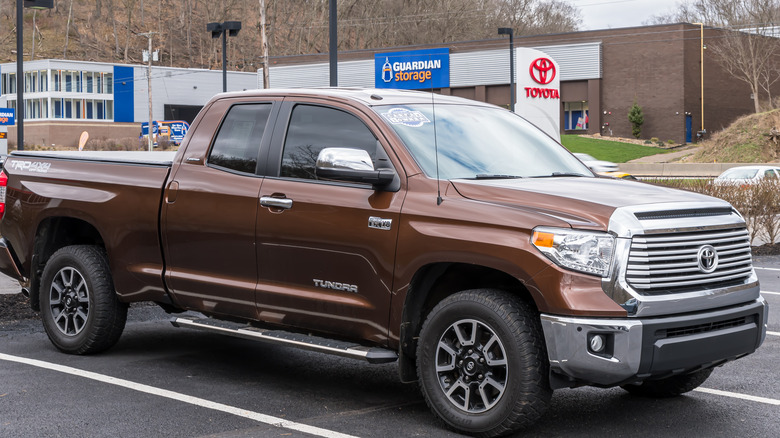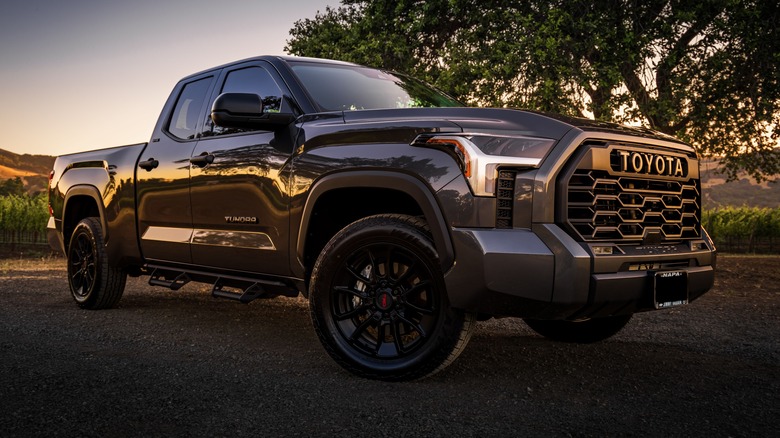In the early 1990s, Toyota faced up to a bigger-is-better attitude among truck drivers in the U.S. market. The Japanese automotive manufacturer was not completely new to the truck market, nor to bringing them to the U.S., with notable early efforts including the Stout — imported in 1964 — unpopular stateside. In fact, only four of them were bought there during its first year on sale.
However, that didn’t mean that light trucks couldn’t sell in the States. After the Stout, Toyota stuck with the market for light trucks, and had success with the SR5 and the beloved 22R engine that joined it in 1981. Furthermore, the decision led to the release of the T100 in 1993. Let’s turn the spotlight on this lesser-known model, with a look at its impact, its fate, and the new truck that would ultimately take its place.
[Image by Walldo123 via Wikimedia Commons | Resized and Cropped | CC BY-SA 4.0]
The T100, an ambitious misfit
Toyota’s past success in the truck market provided a convenient foundation to build on. In following up with the T100, the goal was to combine the power of a larger model with the practicality of something smaller, yet still potent. Inevitably, though, this smaller package made compromises, each playing a part in restricting the model’s appeal among truck drivers.
Weighing 3,350 and 3,430 pounds for the 1993 regular cab and one ton version respectively, it wasn’t exactly a pocket-sized prospect, but neither was it especially big. Pickups can typically weigh up to around 4,700 pounds. At 209.1 inches in length, approximately 17.4 feet, it seemed to occupy an awkward position between small and full-size trucks. Its engine also let it down. The 3 liter V6 that powered the T100 meant that its 180 lb-ft of torque and 150 horsepower didn’t shine, and it could have truly benefited from having a worthy V8. Unfortunately, this wasn’t an option for any model of the truck.
In terms of room for occupants, it left something to be desired there too. Seating only three on launch, without an extended cab, the T100 lacked the dimensions, and subsequently didn’t interest many full-size pickup drivers. A trip back to the drawing board made room for the so-called Xtracab with space for six people from 1995.
[Image by Ric17 via Wikimedia Commons | Resized and Cropped | CC BY 3.0]
The model that replaced the T100

Althom/Getty Images
The reality is, when you try to please everybody, you risk pleasing nobody. In a sense, this is just what happened with the T100, which occupied a curious position between the full-size and smaller truck, while never quite embodying either. «Toyota calls it mid-size,» a MotorWeek Retro Review stated, going on to note that the model is «built around many of the smaller trucks’ components, including the frame, front suspension and even the drivetrain.»
All in all, the T100 remained something of an ill fit for the U.S. market and would sadly perform accordingly. By 1997, it wielded a 3.4 liter V6 with 220 lb-ft of torque and significantly improved horsepower at 190. Nonetheless, 1997’s F150 from Ford far outstripped that with 210 horsepower and torque at 255 lb-ft. What did the F150 have that Toyota’s offering sorely lacked? You guessed it: A V8 engine.
Ultimately, as Curbside Classic reports, 141,531 drivers bought T100s in the United States over its lifetime. That lifetime would last until the following year: 1998 marked the discontinuation of the model. Toyota then had to regroup and demonstrate that it could still carve itself a warm slice of the lucrative truck market pie. The model to provide where the T100 proved lacking was the Toyota Tundra.
The rise of Toyota’s Tundra

Wirestock Creators/Shutterstock
The T100 wasn’t the greatest failure the manufacturer has made, nor one of Toyota’s most curiously-designed vehicles, it simply proved to be out of place with larger competitors. Its successor was first known as the T150, but of course Ford already had an F150. «The company said it will choose an actual name,» the Los Angeles Times reported. «Like its Tacoma model, rather than an alphanumeric designation.» Seeking another catchy T name, the company landed on Tundra.
The Tundra was first produced in 1999. It was clear that great effort was expended to right the T100’s wrongs. The original model, as per Toyota, «had the most sophisticated power-plant ever offered in its class, including the first double-overhead cam, 32-valve V8 in the segment … the first V8 engine to achieve an L.E.V (low emission vehicle) emissions classification from the EPA.» By 2004, the Tundra Double Cab had joined the range, with a bed that Toyota boasted was «approximately seven inches longer than the bed in either the Ford F150 Super Crew or Nissan Titan Crew Cab.» Here was a truck of a size better suited to the U.S. market.